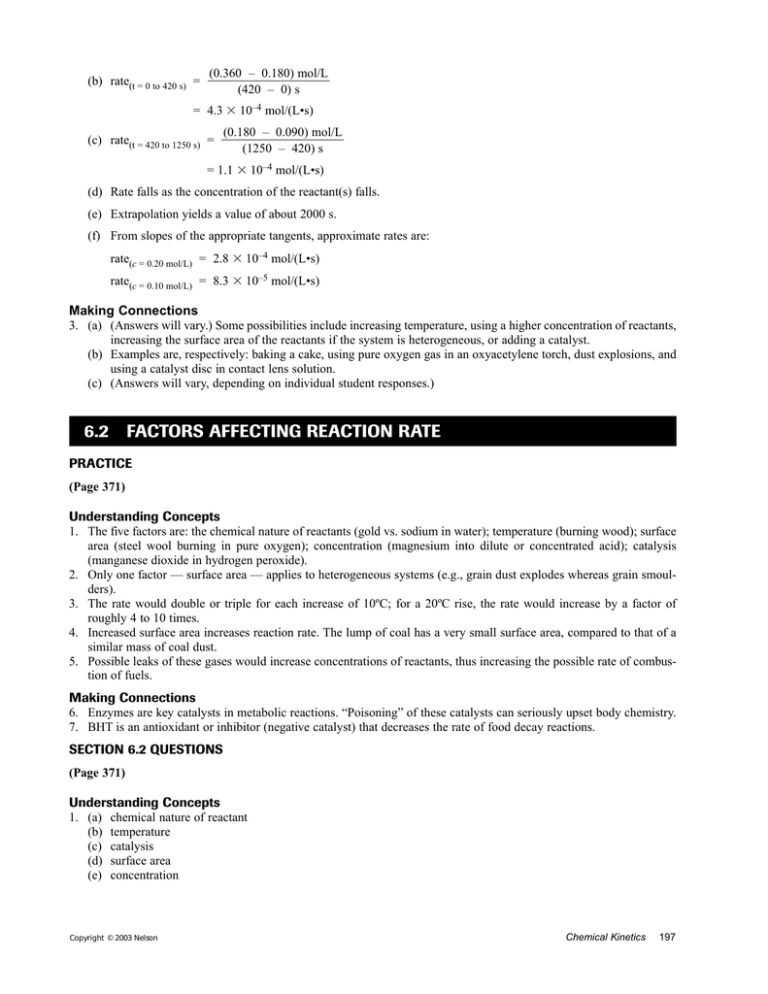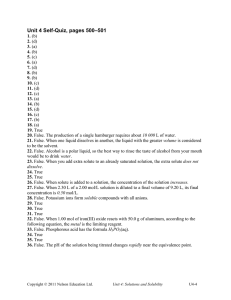(0.360 – 0.180) mol/L (b) rate =
advertisement

(0.360 – 0.180) mol/L (b) rate(t = 0 to 420 s) = (420 – 0) s = 4.3 10–4 mol/(L•s) (0.180 – 0.090) mol/L (c) rate(t = 420 to 1250 s) = (1250 – 420) s = 1.1 10–4 mol/(L•s) (d) Rate falls as the concentration of the reactant(s) falls. (e) Extrapolation yields a value of about 2000 s. (f) From slopes of the appropriate tangents, approximate rates are: rate(c = 0.20 mol/L) = 2.8 10–4 mol/(L•s) rate(c = 0.10 mol/L) = 8.3 10–5 mol/(L•s) Making Connections 3. (a) (Answers will vary.) Some possibilities include increasing temperature, using a higher concentration of reactants, increasing the surface area of the reactants if the system is heterogeneous, or adding a catalyst. (b) Examples are, respectively: baking a cake, using pure oxygen gas in an oxyacetylene torch, dust explosions, and using a catalyst disc in contact lens solution. (c) (Answers will vary, depending on individual student responses.) 6.2 FACTORS AFFECTING REACTION RATE PRACTICE (Page 371) Understanding Concepts 1. The five factors are: the chemical nature of reactants (gold vs. sodium in water); temperature (burning wood); surface area (steel wool burning in pure oxygen); concentration (magnesium into dilute or concentrated acid); catalysis (manganese dioxide in hydrogen peroxide). 2. Only one factor — surface area — applies to heterogeneous systems (e.g., grain dust explodes whereas grain smoulders). 3. The rate would double or triple for each increase of 10ºC; for a 20ºC rise, the rate would increase by a factor of roughly 4 to 10 times. 4. Increased surface area increases reaction rate. The lump of coal has a very small surface area, compared to that of a similar mass of coal dust. 5. Possible leaks of these gases would increase concentrations of reactants, thus increasing the possible rate of combustion of fuels. Making Connections 6. Enzymes are key catalysts in metabolic reactions. “Poisoning” of these catalysts can seriously upset body chemistry. 7. BHT is an antioxidant or inhibitor (negative catalyst) that decreases the rate of food decay reactions. SECTION 6.2 QUESTIONS (Page 371) Understanding Concepts 1. (a) chemical nature of reactant (b) temperature (c) catalysis (d) surface area (e) concentration Copyright © 2003 Nelson Chemical Kinetics 197 2. Hydrochloric acid has a much higher concentration of reactive hydrogen ions in solution than carbonic acid. Most of the carbonic acid remains in solution undissociated. Making Connections 3. To be suitable for starting a campfire, fuel should be flammable (chemical nature), and have a high surface area (more subdivided if a solid). 4. Heterogeneous catalysts are easier to separate from the products and reuse. Since many catalysts are very expensive, reuse is very important economically. For example, vanadium(V) oxide is a solid catalyst used in the industrial production of millions of tonnes of sulfuric acid; platinum is used in the manufacture of nitrogen dioxide, and so on. 5. Catalytic converters are used to remove carbon monoxide, VOCs (volatile organic compounds), and NOx (nitrogen oxides) from exhaust. Two separate types of catalysts, reduction and oxidation catalysts, are arranged in a honeycomb pattern. Nitrogen oxides are reduced to nitrogen and oxygen by the reduction catalyst. The oxidation catalyst changes carbon monoxide and unburned hydrocarbons (VOCs) into carbon dioxide and water. 6.3 RATE LAWS AND ORDER OF REACTION PRACTICE (Page 377) Understanding Concepts 1. Order of reaction refers to the rate dependence or exponential index of one species in the rate law, whereas overall order is the sum of all the indices. If a rate law were r = k[A][B]2, the order of reaction with respect to A would be 1, the order of reaction with respect to B would be 2, and the overall order would be 3. 2. This is a first-order reaction, so doubling the initial concentration should double the initial rate. r 3. (a) k = + ([NH4(aq)] [NO2–(aq)]) 2.40 10–7 mol/(L•s) = (0.200 mol/L 0.00500 mol/L) k = 2.4 10–4 L/(mol•s) (b) r = k[NH4+(aq)][NO2–(aq)] = 3.20 10–4 L/(mol•s) 0.100 mol/L 0.0150 mol/L r = 4.8 10–7 mol/(L•s) 4. (a) (b) 5. (a) (b) 6. (a) Rate is second order with respect to A, first order with respect to B, zeroth order with respect to C. r = k[A]2[B] The reaction rate constant increases. The reaction rate constant is unchanged. When we compare Trials 1 and 2, we see that as [A] is doubled, rate is multiplied by 4; therefore, rate depends on [A]2. When we compare Trials 1 and 3, we see that as [B] is tripled, rate is multiplied by 1; therefore, rate depends on [B]0. When we compare Trials 2 and 4, we see that as [C] is doubled, rate is multiplied by 2; therefore, rate depends on [C]1. (b) r = k [A]2[C]1 (c) When we use data from Trial 1, r k = 2 [A] [C] 3.0 104 mol/(L•s) = (0.10 mol/L)2 0.10 mol/L k = 0.30 L2/(mol2•s) 198 Chapter 6 Copyright © 2003 Nelson






